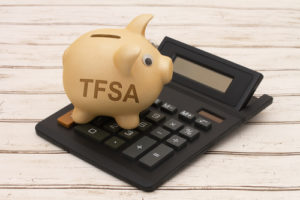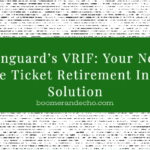Mark Seed’s MyOwnAdvisor website has just published a Q&A with Yours Truly. The Hub often republishes Mark’s blogs here (with his permission of course) and this Q&A covers topics like dividend investing, asset allocation ETFs, hybrid strategies using both and even crypocurrencies.
You can find the original blog by clicking here, or you can read the republished version below:

Mark Seed: “Fun money” is an apt term for monies you can afford to lose. I mean, nobody wants to lose money on purpose of course but there is always an undeniable trade-off when it comes to investing.
Risk and return and related.
Higher risks can signal a higher potential return. Higher risks taken can also signal flat-out failure.
I was curious to hear about how some retirees or semi-retirees invest and keep speculation in their portfolio.
So, I reached out to author, blogger and columnist Jon Chevreau for his thoughts including how much he speculates in his own portfolio, at age 67.
Jon has already contributed to My Own Advisor a few times.
Jon, welcome back to the site to discuss this interesting topic!
Jon Chevreau: Glad to be back Mark.
Mark: In our last post Jon, we talked about low-cost ETF investing, investing in stocks and more in your Victory Lap Retirement book.
Let’s back up a bit…
What should Canadians consider before Do-It-Yourself (DIY) investing? I mean, it’s not for everyone including those in retirement right?

Jon: No, DIY investing is probably not for everyone: some need good advice and like most things in life, you get what you pay for.
If you need a full-service advisor or a fee-based advisor that can add value not just on investments but on tax strategies, estate planning, retirement income, insurance and the like, then paying on the order of 1% a year of assets is not unreasonable. On the other hand, with interest rates so low, the more you can save on the fixed-income portion of a portfolio the better. That applies doubly to retirees, who should have a good percentage of their investments in fixed-income (say 40 to 60% depending on objectives and risk tolerance.) I often tell retired readers that if all they use is a discount brokerage in order to hold a Vanguard or iShares asset allocation ETF, that can be a good compromise: you get the equivalent of near professional stock-picking prowess via indexing, asset allocation and rebalancing all for a very good price; and you could then hire a fee-only financial planner for specific guidance outside that pure investing realm.
(Mark: you can find many of those asset allocation all-in-one ETFs here.)
Mark: Seems wise Jon.
So, given some aspiring retirees might not want to invest entirely alone, what good options might be available to help them out (beyond blogs like yours and mine of course)!? Ha!
Jon: I often direct new or aspiring retirees who are worried about the shift from wealth accumulation to generating regular retirement income to the books by good Canadian authors like Moshe Milevsky, Daryl Diamond and Fred Vettese. Sites like yours and mine probably have reviewed these. There are also several retirement planning software packages that are worth considering; ViviPlan, Cascades and Retirement Navigator, to name three I once reviewed in a Globe & Mail article.
(Mark: you can find many references to those authors and their books below.)
Daryl Diamond – Your Retirement Income Blueprint
Fred Vettese – Retirement Income for Life
Fred Vettese – The Essential Retirement Guide
 Mark: I’ve written about my plan to “live off dividends” and distributions in the early years of semi-retirement, while working part-time, to mitigate any negative sequence of returns risk.
Mark: I’ve written about my plan to “live off dividends” and distributions in the early years of semi-retirement, while working part-time, to mitigate any negative sequence of returns risk.
As someone who is in their semi-retirement years, is that being overly cautious? What are your personal thoughts/approaches on trying to mitigate poor sequence of returns risks?
Jon: Market timing is always fraught with uncertainty so I tend to suggest sticking to your asset allocation plan and adhering to a relatively cautious variant of the 4% Rule. I’m cautious so personally start with a 3% rule: that is, whatever amount you have invested I try to withdraw only about 3% of the value per year. Hopefully, some combination of interest, dividends and capital gains will generate most of that 3% and if sometimes it means breaking a bit into capital, then accept that. We don’t live forever and the occasional down year from a stocks bear market will soon enough be followed by some very good years, like 2020 largely turned out to be. In bad years, be frugal and eschew travel if necessary; in good years, live a little but at least keep investing in your TFSAs. Diversification and asset allocation are our friends but keep in mind the Asset Allocation ETFs are mostly focused on the big three asset classes of stocks, bonds and a bit of cash.
With all this money printing by central banks to cope with COVID-19, I like to include some inflation hedges and so keep maybe 10% in precious metals/gold/silver/platinum and real estate is a good asset class for 5 to 10%, through REIT ETFs that can currently be acquired at bargain prices.
(Mark: Does the 4% rule still make any sense?)
Mark: I own a few REITs for that hedge myself: some REITs do seem very cheap now. Jon, I’ve long since argued that any path to financial wealth should be largely boring – save, invest, stay the course, focus on equities, diversify, minimize fees – and you should end up more than OK after a few decades of this simple path to wealth-building.
Yet the rise of cryptocurrencies, the recent tech boom, and other investing alternatives has me thinking there is absolutely some room for some/a small bit of speculative plays in a portfolio. So, I have a few questions for you.
First, what is your stance on that? I mean, how much should retirees speculate in their portfolio if at all?
Jon: Some believe retirees shouldn’t speculate at all but any retiree counting on current GIC rates will need a much bigger portfolio for that than when interest rates provided a reasonable return. Personally, even as I near age 68, I still invest a lot in technology stocks and lately I have even dipped my toes into cryptocurrencies. Continue Reading…





